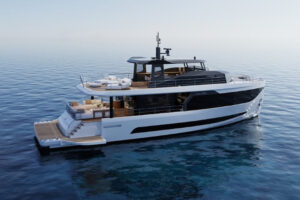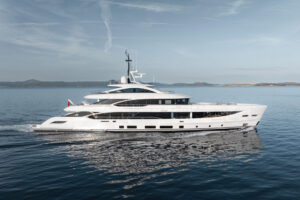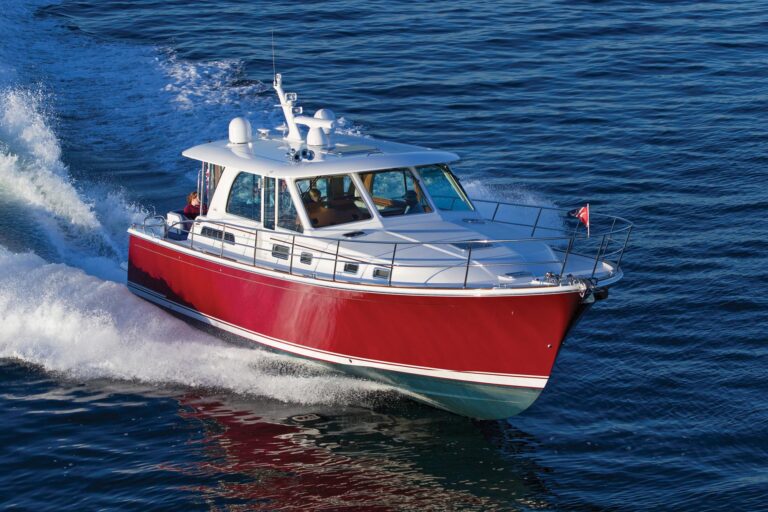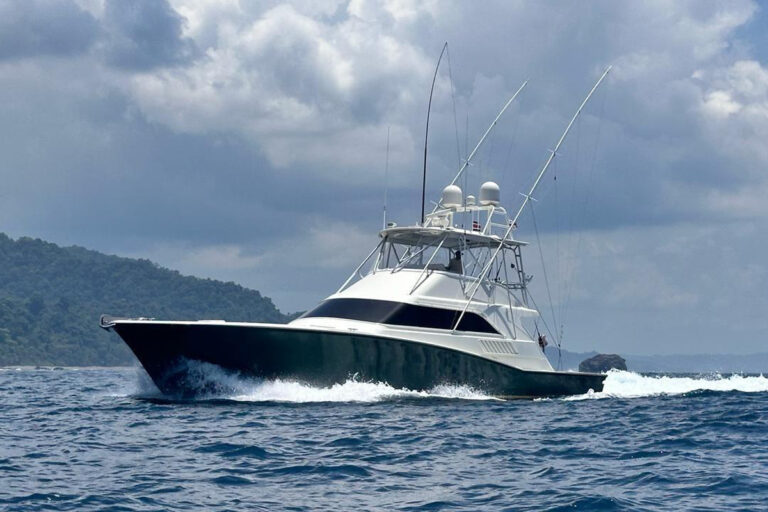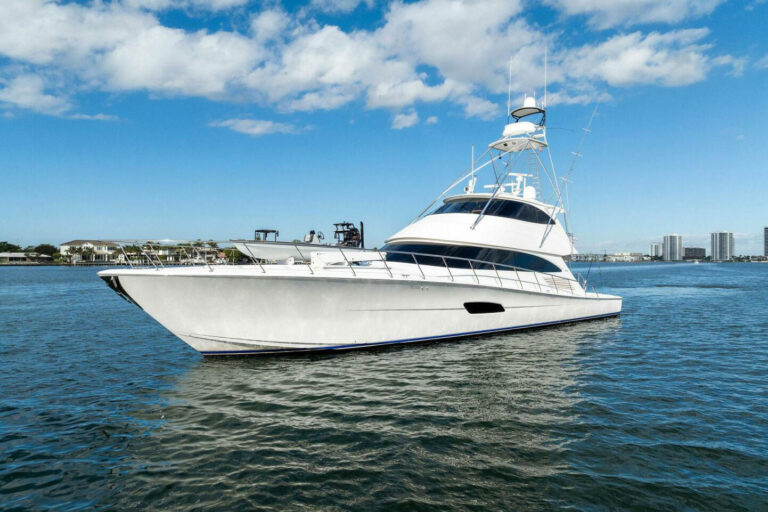For a boatbuilder, a yacht built on speculation is a double-edged sword. On one hand, spec builds satisfy clients who want to use their yachts immediately rather than wait years for completion. A spec yacht also frees the builder from dealing with clients who can be-pardon the expression-mercurial in their desires. This absence of “change orders” allows the yard to build more efficiently, which translates into cost savings.
On the other hand, a spec yacht ties up capital, and perhaps more important, the builder has to find a buyer at the end of construction. For this reason, a spec yacht must be distinctive enough to be desirable, yet neutral enough to interest a wide range of buyers. A builder must dance lightly on the razor’s edge between being memorable and being too memorable, between designing a yacht that is turnkey and one that is a turn-off. By definition, these builds tend toward the inoffensive: You won’t find pink décor or Las Vegas lighting aboard a spec yacht.
Yet this new Westport 130 exudes a warmth and comfort many clients will find immediately attractive, and in details such as the woodwork and décor, it is clear Westport has created a yacht with personality.
“We make a great effort not to be bland”, said David Jones, the CEO of Westport. “We hope that an owner needs only minimal changes to tailor the yacht to their own tastes. We also learn from each client, raising the bar by improving the following yachts in subtle ways.”
In business for four decades, Westport has launched many West Coast yacht builders, providing bare hulls for other companies to finish under their own logos. Recently, Westport has been finishing its own hulls; this is number seven in its series of 130-footers.
The hull, with a 26-foot beam, was designed by Bill Garden and styled by Greg Marshall to create a visually balanced yacht that is pleasing to the eye. The Westport hull is well proven, with Airex coring in the topsides, and sandwich construction in the decks and cabins for thermal and acoustic insulation.
Sheryl Guyon of Pacific Custom Interiors handled the interior, as she did with most Westports. The Brazilian cherry is an unusual choice, since it is warm-brown in tone and marked by interesting grain patterns. Madroña burls decorate many surfaces, and textured wall coverings are used extensively-these will make it easy for the eventual owner to personalize the 130.
Stowage cabinets under the big windows in the main saloon push the seating area into the middle, allowing for walking space behind the twin couches. It’s a thoughtful arrangement, since it places the couches and loose chairs close enough for comfort while allowing crew or guest traffic to flow without interrupting conversations. Those big windows, with Roman blinds, are low enough so that seated guests have panoramic views of the surroundings. A game table is aft, and an ultra-thin, 42-inch Fujitsu plasma TV pops up from the divider/buffet that separates the dining area with twin cherry columns.
The dining table easily accommodates 10 under a vaulted overhead that mimics the shape of the table, and twin marble-top buffets are outboard under the windows. Galley service is simplified via a door to port, and the spacious galley has large windows and Corian counters, with crew-access doors to the side deck and entry foyer. It’s actually a country kitchen-style galley, with a large dinette forward that is as likely to attract guests as it is crew.
The master suite is forward of the entrance lobby to starboard. With its inlaid Crema Marfil marble, it takes full advantage of the beam. The entry passage has a large walk-in closet, and the king berth is under a padded headboard and surrounded by large windows. Bureaus are to port, and a loveseat is to starboard. The his-and-her head is forward, with an inlaid marble sole and a surround for the whirlpool bath faux-painted to match the marble. A large double shower, also with an inlaid marble sole, separates the twin vanity areas.
Four guest cabins open onto the marbled lower foyer, which conceals a walk-in laundry room. Two king-size VIP staterooms-mirror images of each other-are aft, while two twins are forward. Each cabin is amply sized and includes shoji-covered ports, textured wall coverings above cherry wainscoting, and marble-lined heads with showers.
Speaking of guest niceties, the 130 is very well outfitted for a spec yacht. She includes 12 place settings of formal crystal and china, a similar set of Mikasa casual settings, cookware for the galley and barware at each station, plus complete linens from comforters and sheets to table linens.
The 130’s airy, panoramic skylounge is so inviting, guests are likely to desert the main saloon. A full bar with twin stools is built into the forward port corner, while a day head is to starboard, off the pilothouse passageway. To port, a wraparound settee faces a game table, and the skylounge opens onto an expansive afterdeck with an additional settee, teak tables and chairs, and a large spa. The guest areas are delineated by teak planking, while the boat deck easily handles the 17-foot Novurania tender and Nautical Structures 2,000-pound-capacity davit. Both levels of the 130 have full walkaround decks; on this level, the deck becomes a Portuguese bridge forward.
Above the skylounge and reached by curved stairs is a guests-only sundeck, which does not have the usual helm. Two seating areas around tables are forward, and the arch contains a bar, barbecue and galley. A spacious sunpad fills the afterdeck.
The pilothouse is seamanlike, with the proprietary Westport Vessel Information and Control system on a 15-inch flat-screen display that monitors a multitude of sensors throughout the yacht. A raised settee provides a good view past the twin Crown helm chairs over the full-width dashboard with six flat screens, which are easily accessible from the cavernous electronics area under the eyebrow. A chart and communications area is to port, and twin sliding doors open to the wing decks.
The forward crew quarters are large, and the 130 is arranged to allow crew to move freely without disturbing the guests. A double captain’s cabin with an en suite head is to port, while two twin-bunk cabins, also with separate heads, are forward. The crew has a pleasant lounge area that includes a settee, well-equipped galley, full entertainment system and second washer/dryer.
With Westport’s decades of commercial boatbuilding experience, it’s no surprise that the engineroom of the 130 is a model of simplicity and efficiency. Access is from the afterdeck via curving stairs that lead into an air-conditioned engineer’s room, which has control panels for pumps, manifolds and electrical distribution, as well as a large workshop.
The engineroom, with Treadmaster flooring, is arranged for good access to the 2,735 hp MTU-DDC 12V4000 diesels, and the high quality of the systems and installations is evident. Twin Northern Lights 65kW generators supply onboard power, while an ASEA system converts shorepower. The standard equipment-including Naiad stabilizers, a Wesmar bowthruster, Sea Recovery watermakers, Jastrom commercial steering and a Berenzoni passerelle-reflects thoughtful and experienced choices. Abaft the engineroom and providing direct dockside access from the stern platform is the engineer’s cabin, which is finished to guest-area standards with a double berth, desk and head. Opposite the cabin is a huge Traulsen double freezer, stowage lockers and Glendinning shore-cord reels.
With a top speed of 28 knots, a comfortable cruise of 24 knots and a surprisingly long range of 3,450 miles at 12 knots, this hull is clearly an efficient one.
From one of the most experienced composite-yacht builders, the Westport 130 is a shapely and likable offering. Unlike most plain-vanilla spec builds, she is stylishly executed, resulting in a warm, inviting yacht that certainly won’t be on the spec market for long.
Contact: Westport Yachts, (954) 316-6364; www.westportyachts.com. For more information, contact: (866) 922-4877


